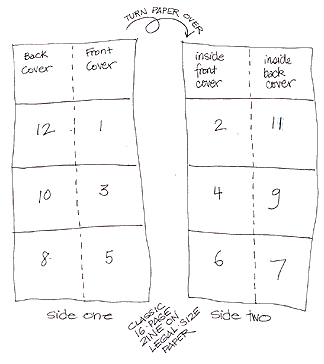Purchases made through my links help support this website, at no additional cost to you. Details.
I published my first zine in 1977. It was one piece of paper, printed on one or two sides, folded, stamped, and sent out with someone’s name & address written on the outside.
In time, I graduated to two or three sheets of paper, and I started rubber stamping & glittering my zines. Yes, each one was hand-decorated.
Since then, I’ve explored nearly every possible variation on the zine theme: Color and b&w; on 8 1/2″ x 17″ paper, and on a single 8 1/2″ x 11″ sheet, folded in half; and so on.
From what I’ve seen, the majority of people who create homegrown zines use letter-sized printed pages (8 1/2″ x 11″) and fold them in half. Each sheet of paper is four pages of the zine.
An average zine (and believe me, that’s an oxymoron!) is five to 15 sheets of paper, meaning 20 to 60 pages.
In swaps, most zines are at the small end of that figure.
In fact, plenty of them are just a sheet or two of paper. They’re printed or photocopied (and sometimes cut). Then they’re folded, and usually stapled to make a zine.
The classic zine design is funky. If you’re a purist, you’ll love this. If you’re on a budget, you’ll also love this: It’s a 16-page zine created with one sheet of legal-sized paper, period.
I don’t count the cover as a “page” when I number my zine pages, so my own version of this is 12 pages plus an outside cover & inside covers. Here’s how it fits on the paper:

Cut on the solid lines and fold on the dotted lines.
Staple in the center. One staple is usually enough.
One stamp on the envelope is enough to mail one of these zines. You can tuck them in with your bill payments, with your notes to friends, with your swaps, with your orders to catalogues, and so on!
You can also scan your zine, uncut, and put it online so others can print their own copy, cut & assemble it. Easy!
But, it won’t hold much info unless you write small enough for a magnifying glass, or you find clever ways to expand the available space, such as adding fold-out pages & stuff.
That said, the 16-pages-from-one-sheet-of-legal-paper is regarded as a classic zine, if we’re talking about all kinds of zines, including poetry, fanzines, and so on.
Oh, sure, there are other ways to make zines. Look at books about making handmade books, for the best inspiration.
The concept is the same, but zines are usually smaller & more informal, that’s all.
If you want to create a zine that’s a work of art, that’s fine. If you want to get wild & crazy with design, that’s fine too.
However, keep in mind that a zine can be one piece of paper, b&w, printed on both sides, and folded in half. And that’s a four-page zine.
Some of these single-page zines are still in my collection. By contrast, I haven’t kept some larger zines, though they were lovely to look at and filled with wonderful sentiments.
So, put your art & soul into your zine, and don’t worry about the size or technical stuff.
I love almost every zine I see. Size, expertise, and visual quality often have nothing to do with how enthusiastic I am about a zine!
What I’m saying is: If you’ve wanted to create a zine for fun, or just to see what it’s like to make one, just do it!
The bonus is, if you swap your zines with others, you’ll receive fabulous zines in return, which you might never see if you hadn’t swapped.

this is super cool and very helpful! 🙂 your whole website is great and i’ve been referring to it for some time, but somehow i missed the zine section. it’s terrific!